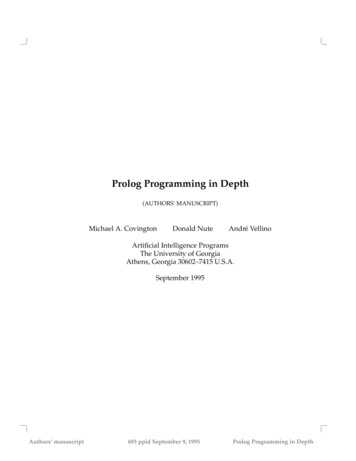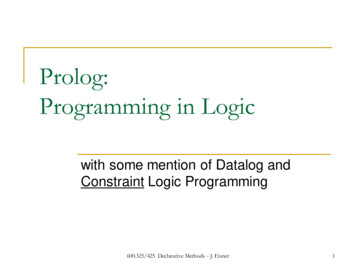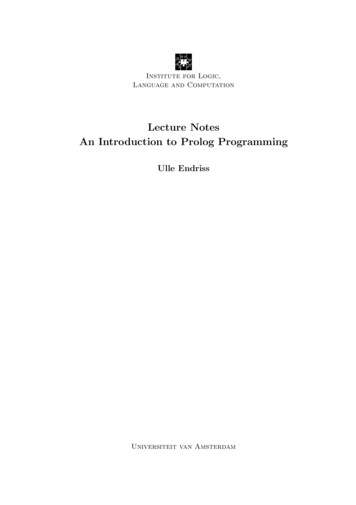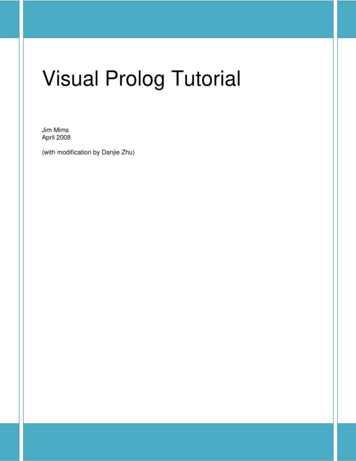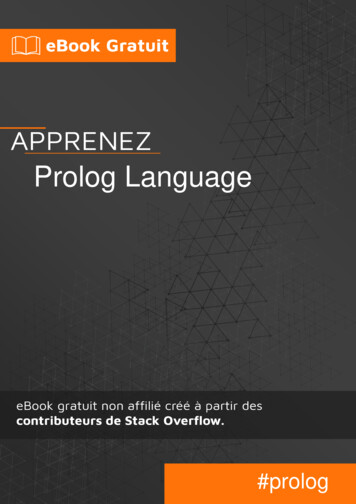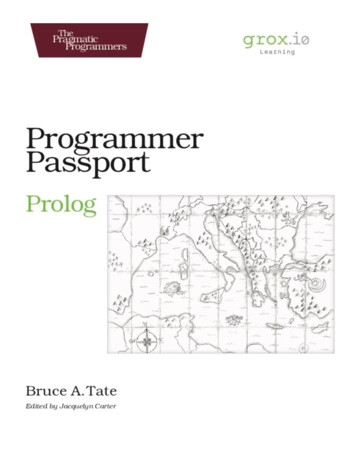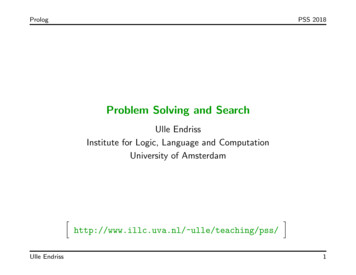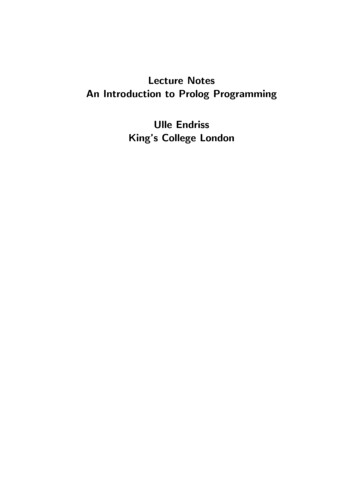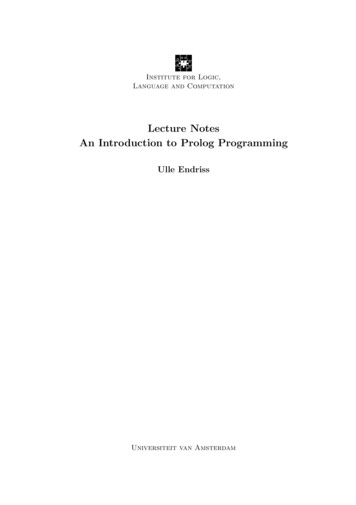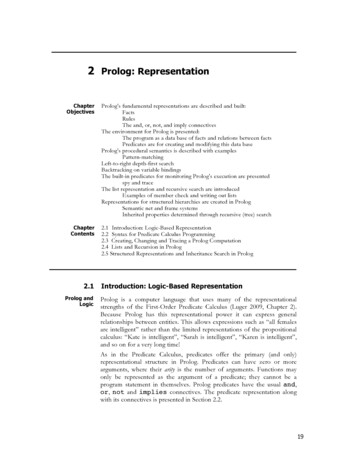
Transcription
2 Prolog: rolog andLogicProlog’s fundamental representations are described and built:FactsRulesThe and, or, not, and imply connectivesThe environment for Prolog is presented:The program as a data base of facts and relations between factsPredicates are for creating and modifying this data baseProlog’s procedural semantics is described with examplesPattern-matchingLeft-to-right depth-first searchBacktracking on variable bindingsThe built-in predicates for monitoring Prolog’s execution are presentedspy and traceThe list representation and recursive search are introducedExamples of member check and writing out listsRepresentations for structured hierarchies are created in PrologSemantic net and frame systemsInherited properties determined through recursive (tree) search2.1 Introduction: Logic-Based Representation2.2 Syntax for Predicate Calculus Programming2.3 Creating, Changing and Tracing a Prolog Computation2.4 Lists and Recursion in Prolog2.5 Structured Representations and Inheritance Search in PrologIntroduction: Logic-Based RepresentationProlog is a computer language that uses many of the representationalstrengths of the First-Order Predicate Calculus (Luger 2009, Chapter 2).Because Prolog has this representational power it can express generalrelationships between entities. This allows expressions such as “all femalesare intelligent” rather than the limited representations of the propositionalcalculus: “Kate is intelligent”, “Sarah is intelligent”, “Karen is intelligent”,and so on for a very long time!As in the Predicate Calculus, predicates offer the primary (and only)representational structure in Prolog. Predicates can have zero or morearguments, where their arity is the number of arguments. Functions mayonly be represented as the argument of a predicate; they cannot be aprogram statement in themselves. Prolog predicates have the usual and,or, not and implies connectives. The predicate representation alongwith its connectives is presented in Section 2.2.19
20Part II: Programming in PrologProlog also takes on many of the declarative aspects of the PredicateCalculus in the sense that a program is simply the set of all true predicatesthat describe a domain. The Prolog interpreter can be seen as a “theoremprover” that takes the user’s query and determines whether or not it is true,as well as what variable substitutions might be required to make the querytrue. If the query is not true in the context of the program’s specifications,the interpreter says “no.”2.2 PrologIntroduction:Syntax Logic-Based RepresentationFacts, RulesandConnectivesAlthough there are numerous dialects of Prolog, the syntax usedthroughout this text is that of the original Warren and Pereira C-Prolog asdescribed by Clocksin and Mellish (2003). We begin with the set ofconnectives that can take atomic predicates and join them with otherexpressions to make more complex relationships. There are, because of theusual keyboard conventions, a number of differences between Prolog andpredicate calculus syntax. In C-Prolog, for example, the symbol :- replacesthe of first-order predicate calculus. The Prolog connectives include:ENGLISHPREDICATE CALCULUSPrologand ,orv;only if :-not notIn Prolog, predicate names and bound variables are expressed as asequence of alphanumeric characters beginning with an alphabetic.Variables are represented as a string of alphanumeric characters beginning(the first character, at least) with an uppercase alphabetic. Thus:likes(X, susie).or, better,likes(Everyone, susie).could represent the fact that “everyone likes Susie.” Note that the scope ofall variables is universal to that predicate, i.e., when a variable is used in apredicate it is understood that it is true for all the domain elements withinits scope. For example,likes(george, Y), likes(susie, Y).represents the set of things (or people) liked by BOTH George and Susie.Similarly, suppose it was desired to represent in Prolog the followingrelationships: “George likes Kate and George likes Susie.” This could bestated as:likes(george, kate), likes(george, susie).Likewise, “George likes Kate or George likes Susie”:likes(george, kate); likes(george, susie).Finally, “George likes Susie if George does not like Kate”:likes(george, susie) :- not(likes(george, kate)).
Chapter 2 Prolog: Representation21These examples show how the predicate calculus connectives are expressedin Prolog. The predicate names (likes), the number or order of parameters,and even whether a given predicate always has the same number ofparameters are determined by the design requirements (the implicit“semantics”) of the problem.The form Prolog expressions take, as in the examples above, is a restrictedform of the full predicate calculus called the “Horn Clause calculus.” Thereare many reasons supporting this restricted form, most important is thepower and computational efficiency of a resolution refutation system. For detailssee Luger (2009, Chapter 14).A SimplePrologProgramA Prolog program is a set of specifications in the first-order predicatecalculus describing the objects and relations in a problem domain. The setof specifications is referred to as the database for that problem. The Prologinterpreter responds to questions about this set of specifications. Queries tothe database are patterns in the same logical syntax as the database entries.The Prolog interpreter uses pattern-directed search to find whether thesequeries logically follow from the contents of the database.The interpreter processes queries, searching the database in left to rightdepth-first order to find out whether the query is a logical consequence ofthe database of specifications. Prolog is primarily an interpreted language.Some versions of Prolog run in interpretive mode only, while others allowcompilation of part or all of the set of specifications for faster execution.Prolog is an interactive language; the user enters queries in response to theProlog prompt, “?-“.Let us describe a “world” consisting of George’s, Kate’s, and Susie’s likesand dislikes. The database might contain the following set of predicates:likes(george, kate).likes(george, susie).likes(george, wine).likes(susie, wine).likes(kate, gin).likes(kate, susie).This set of specifications has the obvious interpretation, or mapping, intothe world of George and his friends. That world is a model for the database(Luger 2009, Section 2.3). The interpreter may then be asked questions:?- likes(george, kate).Yes?- likes(kate, susie).Yes?- likes(george, X).X kate;X Susie;X wine
22Part II: Programming in Prolog;no?- likes(george, beer).noNote first that in the request likes(george, X), successive userprompts (;) cause the interpreter to return all the terms in the databasespecification that may be substituted for the X in the query. They arereturned in the order in which they are found in the database: kate beforesusie before wine. Although it goes against the philosophy ofnonprocedural specifications, a determined order of evaluation is aproperty of most interpreters implemented on sequential machines.To summarize: further responses to queries are produced when the userprompts with the ; (or). This forces the rejection of the current solutionand a backtrack on the set of Prolog specifications for answers. Continuedprompts force Prolog to find all possible solutions to the query. When nofurther solutions exist, the interpreter responds no.This example also illustrates the closed world assumption or negation as failure.Prolog assumes that “anything is false whose opposite is not provablytrue.” For the query likes(george, beer), the interpreter looks forthe predicate likes(george, beer) or some rule that couldestablish likes(george, beer). Failing this, the request is false.Prolog assumes that all knowledge of the world is present in the database.The closed world assumption introduces a number of practical andphilosophical difficulties in the language. For example, failure to include afact in the database often means that its truth is unknown; the closed worldassumption treats it as false. If a predicate were omitted or there were amisspelling, such as likes(george, beeer), the response remainsno. Negation-as-failure issue is an important topic in AI research. Thoughnegation-as-failure is a simple way to deal with the problem of unspecifiedknowledge, more sophisticated approaches, such as multi-valued logics(true, false, unknown) and nonmonotonic reasoning (see Luger2009, Section 9.1), provide a richer interpretive context.The Prolog expressions just seen are examples of fact specifications. Prologalso supports rule predicates to describe relationships between facts. We usethe logical implication :- . For rules, only one predicate is permitted onthe left-hand side of the if symbol :-, and this predicate must be a positiveliteral, which means it cannot have not in front of it. All predicate calculusexpressions that contain logical implication must be reduced to this form,referred to as Horn clause logic. In Horn clause form, the left-hand side(conclusion) of an implication must be a single positive literal. The Hornclause calculus is equivalent to the full first-order predicate calculus for proofsby refutation (Luger 2009, Chapter 14).Suppose we add to the specifications of the previous database a rule fordetermining whether two people are friends. This may be defined:friends(X, Y) :- likes(X, Z), likes(Y, Z).This expression might be interpreted as “X and Y are friends if there existsa Z such that X likes Z and Y likes Z.” Two issues are important here. First,
Chapter 2 Prolog: Representation23because neither the predicate calculus nor Prolog has global variables, thescopes (extent of definition) of X, Y, and Z are limited to the friendsrule. Second, values bound to, or unified with, X, Y, and Z are consistentacross the entire expression. The treatment of the friends rule by theProlog interpreter is seen in the following example.With the friends rule added to the set of specifications of the precedingexample, we can query the interpreter:?- friends(george, susie).yesTo solve this query, Prolog searches the database using the backtrackalgorithm. Briefly, backtrack examines each predicate specification in theorder that it was placed in the Prolog. If the variable bindings of thespecification satisfy the query it accepts them. If they don’t, the interpretergoes on to the next specification. If the interpreter runs into a dead end,i.e., no variable substitution satisfies it, then it backs up looking for othervariable bindings for the predicates it has already satisfied. For example,using the predicate specifications of our current example, the queryfriends(george, susie) is unified with the conclusion of the rulefriends(X, Y) :- likes(X, Z), likes(Y, Z), with X asgeorge and Y as susie. The interpreter looks for a Z such thatlikes(george, Z) is true and uses the first fact, with Z as kate.The interpreter then tries to determine whether likes(susie,kate) is true. When it is found to be false, using the closed worldassumption, this value for Z (kate) is rejected. The interpreter backtracksto find a second value for Z. likes(george, Z) then matches thesecond fact, with Z bound to susie. The interpreter then tries to matchlikes(susie, susie). When this also fails, the interpreter goesback to the database for yet another value for Z. This time wine is foundin the third predicate, and the interpreter goes on to show thatlikes(susie, wine) is true. In this case wine is the binding thatties george and susie.It is important to state the relationship between universal and existentialquantification in the predicate calculus and the treatment of variables in aProlog program. When a variable is placed in the specifications of a Prologdatabase, it is universally quantified. For example, likes(susie, Y)means, according to the semantics of the previous examples, “Susie likeseveryone.” In the course of interpreting a query, any term, or list, orpredicate from the domain of Y, may be bound to Y. Similarly, in the rulefriends(X, Y) :- likes(X, Z), likes(Y, Z), any X, Y,and Z that meets the specifications of the expression are used.To represent an existentially quantified variable in Prolog, we may take twoapproaches. First, if the existential value of a variable is known, that valuemay be entered directly into the database. Thus, likes(george,wine) is an instance of likes(george, Z).Second, to find an instance of a variable that makes an expression true, wequery the interpreter. For example, to find whether a Z exists such thatlikes(george, Z) is true, we put this query to the interpreter. It will
24Part II: Programming in Prologfind whether a value of Z exists under which the expression is true. SomeProlog interpreters find all existentially quantified values; C-Prolog requiresrepeated user prompts (;), as shown previously, to get all values.2.3 Creating,Introduction:Changing,Logic-Basedand TracingRepresentationa Prolog ComputationIn building a Prolog program the database of specifications is created first.In an interactive environment the predicate assert can be used to addnew predicates to the set of specifications. Thus:?- assert(likes(david, sarah)).adds this predicate to the computing specifications. Now, with the query:?- likes(david, X).X sarah.is returned. assert allows further control in adding new specifications tothe database: asserta(P) asserts the predicate P at the beginning of allthe predicates P, and assertz(P) adds P at the end of all the predicatesnamed P. This is important for search priorities and building heuristics. Toremove a predicate P from the database retract(P) is used. (It shouldbe noted that in many Prologs assert can be unpredictable in that theexact entry time of the new predicate into the environment can varydepending on what other things are going on, affecting both the indexingof asserted clauses as well as backtracking.)It soon becomes tedious to create a set of specifications using thepredicates assert and retract. Instead, the good programmer takesher favorite editor and creates a file containing all the Prolog program’sspecifications. Once this file is created, call it myfile, and Prolog iscalled, then the file is placed in the database by the Prolog commandconsult. Thus:?- consult(myfile).yesintegrates the predicates in myfile into the database. A short form of theconsult predicate, and better for adding multiple files to the database,uses the list notation, to be seen shortly:?- [myfile].yesIf there are any syntax errors in your Prolog code the consult operatorwill describe them at the time it is called.The predicates read and write are important for user/systemcommunication. read(X) takes the next term from the current inputstream and binds it to X. Input expressions are terminated with a “.”write(X) puts X in the output stream. If X is unbound then an integerpreceded by an underline is printed ( 69). This integer represents theinternal bookkeeping on variables necessary in a theorem-provingenvironment (see Luger 2009, Chapter 14).The Prolog predicates see and tell are used to read information fromand place information into files. see(X) opens the file X and defines thecurrent input stream as originating in X. If X is not bound to an available
Chapter 2 Prolog: Representation25file see(X) fails. Similarly, tell(X) opens a file for the output stream.If no file X exists, tell(X) creates a file named by the bound value of X.seen(X) and told(X) close the respective files.A number of Prolog predicates are important in helping keep track of thestate of the Prolog database as well as the state of computing about thedatabase; the most important of these are listing, trace, and spy. Ifwe use listing(predicate name) where predicate name isthe name of a predicate, such as friends (above), all the clauses withthat predicate name in the database are returned by the interpreter. Notethat the number of arguments of the predicate is not indicated; in fact, alluses of the predicate, regardless of the number of arguments, are returned.trace allows the user to monitor the progress of the Prolog interpreter.This monitoring is accomplished by printing to the output file every goalthat Prolog attempts, which is often more information than the user wantsto have. The tracing facilities in Prolog are often rather cryptic and takesome study and experience to understand. The information available in atrace of a Prolog program usually includes the following:The depth level of recursive calls (marked left to right on line).When a goal is tried for the first time (sometimes call is used).When a goal is successfully satisfied (with an exit).When a goal has further matches possible (a retry).When a goal fails because all attempts to satisfy it have failedThe goal notrace stops the exhaustive tracing.When a more selective trace is required the goal spy is useful. Thispredicate takes a predicate name as argument but sometimes is defined as aprefix operator where the predicate to be monitored is listed after theoperator. Thus, spy member causes the interpreter to print to output alluses of the predicate member. spy can also take a list of predicatesfollowed by their arities: spy[member/2, append/3] monitorsmember with two arguments and append with three. nospy removesthese spy points.2.4Lists and Recursion in PrologThe previous subsections presented Prolog syntax with several simpleexamples. These examples introduced Prolog as an engine for computingwith predicate calculus expressions (in Horn clause form). This isconsistent with all the principles of predicate calculus inference presentedin Luger (2009, Chapter 2). Prolog uses unification for pattern matchingand returns the bindings that make an expression true. These values areunified with the variables in a particular expression and are not bound inthe global environment.Recursion is the primary control mechanism for Prolog programming. Wewill demonstrate this with several examples. But first we consider somesimple list-processing examples. The list is a data structure consisting ofordered sets of elements (or, indeed, lists). Recursion is the natural way toprocess the list structure. Unification and recursion come together in list
26Part II: Programming in Prologprocessing in Prolog. The set of elements of a list are enclosed by brackets,[ ], and are separated by commas. Examples of Prolog lists are:[1, 2, 3, 4][[george, kate], [allen, amy], [richard, shirley]][tom, dick, harry, fred][ ]The first elements of a list may be separated from the tail of the list by thebar operator, . The tail of a list is the list with its first element removed.For instance, when the list is [tom,dick,harry,fred], the firstelement is tom and the tail is the list [dick, harry, fred]. Usingthe vertical bar operator and unification, we can break a list into itscomponents:If [tom, dick, harry, fred] is matched to [X Y],then X tom and Y [dick, harry, fred].If [tom,dick,harry,fred] is matched to the pattern[X, Y Z], then X tom , Y dick , and Z [harry, fred].If [tom, dick, harry, fred] is matched to [X, Y, Z W], then X tom, Y dick, Z harry, and W [fred].If [tom, dick, harry, fred] is matched to [W, X, Y,Z V], then W tom, X dick, Y harry, Z fred,and V [ ].[tom, dick, harry, fred] will not match [V, W, X, Y,Z U].[tom, dick, harry, fred] will[harry, fred]], to give X dick.match[tom,X Besides “tearing lists apart” to get at particular elements, unification can beused to “build” the list structure. For example, if X tom, Y [dick] when L unifies with [X Y], then L will be bound to [tom,dick]. Thus terms separated by commas before the are all elements ofthe list, and the structure after the is always a list, the tail of the list.Let’s take a simple example of recursive processing of lists: the membercheck. We define a predicate to determine whether an item, represented byX, is in a list. This predicate member takes two arguments, an element anda list, and is true if the element is a member of the list. For example:?- member(a, [a, b, c, d, e]).yes?- member(a, [1, 2, 3, 4]).no?- member(X, [a, b, c]).X a;X b;X c
Chapter 2 Prolog: Representation27;noTo define member recursively, we first test if X is the first item in the list:member(X, [X T]).This tests whether X and the first element of the list are identical. Not thatthis pattern will match no matter what X is bound to: an atom, a list,whatever! If the two are not identical, then it is natural to check whether Xis an element of the rest (T) of the list. This is defined by:member(X, [Y T]) :- member(X, T).The two lines of Prolog for checking list membership are then:member(X, [X T]).member(X, [Y T]) :- member(X, T).This example illustrates the importance of Prolog’s built-in order of searchwith the terminating condition placed before the recursive call, that is, to betested before the algorithm recurs. If the order of the predicates is reversed,the terminating condition may never be checked. We now tracemember(c,[a,b,c]), with numbering:1: member(X, [X T]).2: member(X, [Y T]) :- member(X, T).?- member(c, [a, b, c]).call 1. fail, since c acall 2. X c, Y a, T [b, c],member(c, [b,c])?call 1. fail, since c bcall 2. X c, Y b, T [c],member(c, [c])?call 1. success, c cyes (to second call 2.)yes (to first call 2.)yesGood Prolog style suggests the use of anonymous variables. These serve as anindication to the programmer and interpreter that certain variables are usedsolely for pattern-matching purposes, with the variable binding itself notpart of the computation process. Thus, when we test whether the elementX is the same as the first item in the list we usually say: member(X,[X ]). The use of the indicates that even though the tail of the listplays a crucial part in the unification of the query, the content of the tail ofthe list is unimportant. In the member check the anonymous variableshould be used in the recursive statement as well, where the value of thehead of the list is unimportant:member(X, [X ]).member(X, [ T]) :- member(X, T).Writing out a list one element to a line is a nice exercise for understandingboth lists and recursive control. Suppose we wish to write out the list[a,b,c,d]. We could define the recursive command:writelist([ ]).writelist([H T]) :- write(H), nl, writelist(T).
28Part II: Programming in PrologThis predicate writes one element of the list on each line, as nl requires theoutput stream controller to begin a new line.If we wish to write out a list in reversed order the recursive predicate mustcome before the write command. This guarantees that the list istraversed to the end before any element is written. At that time the lastelement of the list is written followed by each preceding element as therecursive control comes back up to the top. A reverse write of a list wouldbe:reverse writelist([ ]).reverse writelist([H T]) :- reverse writelist(T),write(H), nl.The reader should run writelist and reverse writelist withtrace to observe the behavior of these predicates.2.5Semantic Netsin PrologStructured Representations and Inheritance SearchStructured representations are an important component of the AIrepresentational toolkit (Collins and Quillian 1969, Luger 2009). They alsosupport many of the design patterns mentioned in Chapter 1. In this andthe following section we consider two structured representations, thesemantic net, and frames that are used almost ubiquitously in AI. We nowpropose a simple semantic network representational structure in Prolog anduse recursive search to implement inheritance. Our language ignores theimportant distinction between classes and instances. This restrictionsimplifies the implementation of inheritance.In the semantic net of Figure 2.1, nodes represent individuals such as thecanary tweety and classes such as ostrich, crow, robin, bird,and vertebrate. isa links represent the class hierarchy relationship.We adopt canonical forms for the data relationships within the net. We usean isa(Type, Parent) predicate to indicate that Type is a memberof Parent and a hasprop(Object, Property, Value)predicate to represent property relations. hasprop indicates thatObject has Property with Value. Object and Value are nodes inthe network, and Property is the name of the link that joins them.A partial list of predicates describing the bird hierarchy of Figure 2.1 is:isa(canary, bird).hasprop(tweety, color, white)isa(robin, bird).hasprop(robin, color, red).isa(ostrich, bird).hasprop(canary, color, yellow).isa(penguin, bird).hasprop(penguin, color, brown).isa(bird, animal).hasprop(bird, travel, fly).isa(fish, animal).hasprop(ostrich, travel, walk).isa(opus, penguin).hasprop(fish, travel, swim).isa(tweety, canary). hasprop(robin, sound, sing).hasprop(canary, sound, sing).hasprop(bird, cover, feathers).hasprop(animal, cover, skin).
Chapter 2 Prolog: Representation29Figure 2.1 A semantic net for a bird hierarchy reflecting the Prolog code.We create a recursive search algorithm to find whether an object in oursemantic net has a particular property. Properties are stored in the net atthe most general level at which they are true. Through inheritance, anindividual or subclass acquires the properties of its superclasses. Thus theproperty fly holds for bird and all its subclasses. Exceptions are locatedat the specific level of the exception. Thus, ostrich and penguintravel by walking instead of flying. The hasproperty predicate beginssearch at a particular object. If the information is not directly attached tothat object, hasproperty follows isa links to superclasses. If no moresuperclasses exist and hasproperty has not located the property, itfails.hasproperty(Object, Property, Value) :hasprop(Object, Property, Value).hasproperty(Object, Property, Value) :isa(Object, Parent),hasproperty(Parent, Property, Value).hasproperty searches the inheritance hierarchy in a depth-first fashion.In the next section, we show how inheritance can be applied to a framebased representation with both single and multiple-inheritance relations.Frames inPrologSemantic nets can be partitioned, with additional information added tonode descriptions, to give them a frame-like structure (Minsky 1975, Luger2009). We present the bird example again using frames, where each framerepresents a collection of relationships of the semantic net and the isaslots of the frame define the frame hierarchy as in Figure 2.2.The first slot of each of the frames name that node, for example,name(tweety) or name(vertebrate). The second slot gives theinheritance links between that node and its parents. Because our example
30Part II: Programming in Prologhas a tree structure, each node has only one link, the isa predicate withone argument. The third slot in the node’s frame is a list of features thatdescribe that node. In this list we use any Prolog predicate such as flies,feathers, or color(brown). The final slot in the frame is the list ofexceptions and default values for the node, again either a single word orpredicate indicating a property.In our frame language, each frame organizes its slot names into lists ofproperties and default values. This allows us to distinguish these differenttypes of knowledge and give them different behaviors in the inheritancehierarchy. Although our implementation allows subclasses to inheritproperties from both lists, other representations are possible and may beuseful in certain applications. We may wish to specify that only defaultvalues are inherited. Or we may wish to build a third list containing theproperties of the class itself rather than the members, sometimes called classvalues. For example, we may wish to state that the class canary names aspecies of songbird. This should not be inherited by subclasses orinstances: tweety does not name a species of songbird. Furtherextensions to this example are suggested in the exercises.We now represent the relationships in Figure 2.2 with the Prolog factpredicate frame with four arguments. We may use the methods suggestedin Chapter 5 to check the parameters of the frame predicate for appropriatetype, for instance, to ensure that the third frame slot is a list that containsonly values from a fixed list of ies), feathers],[ (yellow), canary),[ ],[color(white)]).Once the full set of descriptions and inheritance relationships are definedfor the frame of Figure 2.2, we create procedures to infer properties fromthis representation:get(Prop, Object) :frame(name(Object), , List of properties, ),member(Prop, List of properties).
Chapter 2 Prolog: Representation31Figure 2.2 A frame system reflecting the Prolog code in the text.get(Prop, Object) :frame(name(Object), , List of defaults),member(Prop, List of defaults).get(Prop, Object) :frame(name(Object), isa(Parent), , ),get(Prop, Parent).If the frame structure allows multiple inheritance of properties, we makethis change both in our representation and in our search strategy. First, inthe frame representation we make the argument of the isa predicate a listof superclasses of the Object. Thus, each superclass in the list is a parentof the entity named in the first argument of frame. If opus is apenguin and a cartoon char we represent this:frame(name(opus),isa([penguin, cartoon char]),[color(black)],[ ]).Now, we test for properties of opus by recurring up the isa hierarchyfor both penguin and cartoon char. We add the following getdefinition between the third and fourth get predicates of the previousexample.get(Prop, Object) :frame(name(Object), isa(List), , ),get multiple(Prop, List).
32Part II: Programming in PrologWe define
2.5 Structured Representations and Inheritance Search in Prolog 2.1 Introduction: Logic-Based Representation Prolog and Logic Prolog is a computer language that uses many of the representational strengths of the First-Order Predicate Calculus (Luger 2009, Chapter 2). Because Prolog has this representational power it can express general
